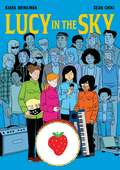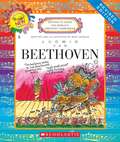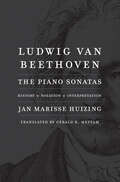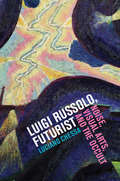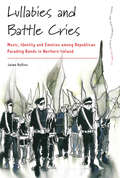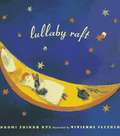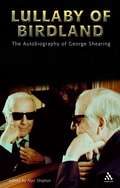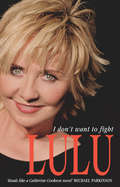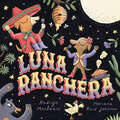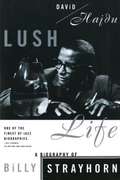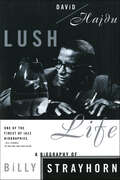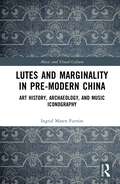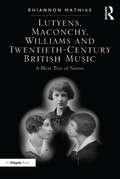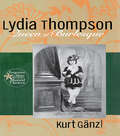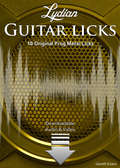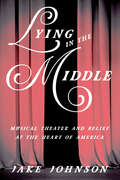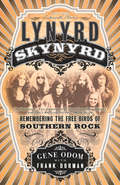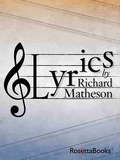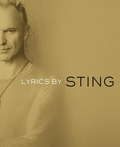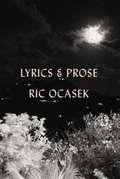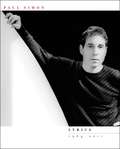- Table View
- List View
Lucy in the Sky
by Kiara BrinkmanIn this contemporary graphic novel, twelve-year-old Lucy discovers her father's collection of Beatles records and is inspired to form an all-girl rock band.It’s the first day of seventh grade, and everything is going downhill for Lucy Sutcliffe. At school, she has the feeling her friends are all leaving her behind. At home, her single father is in a rut, and her perpetually traveling photojournalist mother is more absent than ever. Worst of all, Lucy’s grandmother is undergoing chemotherapy and is no longer the warm, vibrant presence that her family has come to depend on.But everything changes the day Lucy discovers a box of her father’s Beatles records. Inspired by their music, she gets a drum set and forms an all-girl rock band with her friends. But can she keep the band together when petty rivalries, unrequited crushes, and outside pressures threaten to tear it apart?
Ludwig Van Beethoven (Getting To Know The World's Greatest Composers)
by Mike VeneziaPresents a biography of Ludwig Van Beethhoven
Ludwig van Beethoven: The Piano Sonatas; History, Notation, Interpretation
by Jan Marisse HuizingA comprehensive and immersive survey of thirty-five Beethoven piano sonatas &“Beethoven piano sonatas accompany every pianist, amateur or professional for his or her entire life and constitute one of the most miraculous constants of the human civilization. To help us around the exciting journey through those masterpieces Jan Marisse Huizing combines his expertise, knowledge, and above all his unconditional love for this music.&”— Alexander Melnikov, pianist Beethoven&’s piano sonatas are among the iconic cornerstones of the classical music repertoire. Jan Marisse Huizing offers an in-depth study of the sonatas using available autographs, first editions, recordings, and nearly three hundred musical examples. Digging into the historical background and historical performance practice, the book provides illuminating detail on Beethoven&’s pianism as well as his characteristics of notation, form and content, &“types of touch,&” articulation, beaming, pedal indications, character, rubato, meter, metric constructions, tempo, and metronome marks. Packed with anecdotes, quotations, and considerable new information, the book will inspire all involved with these masterworks, playing a fortepiano or modern Grand, giving the sense of the composer sitting beside them as he translates his inspiration and ideas into his notation.
Luigi Dallapiccola and Musical Modernism in Fascist Italy
by Ben EarleLuigi Dallapiccola is widely considered a defining figure in twentieth-century Italian musical modernism, whose compositions bear passionate witness to the historical period through which he lived. In this book, Ben Earle focuses on three major works by the composer: the one-act operas Volo di notte ('Night Flight') and Il prigioniero ('The Prisoner'), and the choral Canti di prigionia ('Songs of Imprisonment'), setting them in the context of contemporary politics to trace their complex path from fascism to resistance. Earle also considers the wider relationship between musical modernism and Italian fascism, exploring the origins of musical modernism and investigating its place in the institutional structures created by Mussolini's regime. In doing so, he sheds new light on Dallapiccola's work and on the cultural politics of the early twentieth century to provide a history of musical modernism in Italy from the fin de siècle to the early Cold War.
Luigi Russolo, Futurist
by Luciano ChessaLuigi Russolo (1885-1947)--painter, composer, builder of musical instruments, and first-hour member of the Italian Futurist movement--was a crucial figure in the evolution of twentieth-century aesthetics. As creator of the first systematic poetics of noise and inventor of what has been considered the first mechanical sound synthesizer, Russolo looms large in the development of twentieth-century music. In the first English language study of Russolo, Luciano Chessa emphasizes the futurist's interest in the occult, showing it to be a leitmotif for his life and a foundation for his art of noises. Chessa shows that Russolo's aesthetics of noise, and the machines he called the intonarumori, were intended to boost practitioners into higher states of spiritual consciousness. His analysis reveals a multifaceted man in whom the drive to keep up with the latest scientific trends coexisted with an embrace of the irrational, and a critique of materialism and positivism.
Lullabies and Battle Cries: Music, Identity and Emotion among Republican Parading Bands in Northern Ireland (Dance and Performance Studies #13)
by Jaime RollinsSet against a volatile political landscape, Irish republican culture has struggled to maintain continuity with the past, affirm legitimacy in the present, and generate a sense of community for the future. Lullabies and Battle Cries explores the relationship between music, emotion, memory, and identity in republican parading bands, with a focus on how this music continues to be utilized in a post-conflict climate. As author Jaime Rollins shows, rebel parade music provides a foundational idiom of national and republican expression, acting as a critical medium for shaping new political identities within continually shifting dynamics of republican culture.
Lullaby Raft
by Naomi Shihab NyeFrom the book: One night, a child a chicken a bunny a turtle and a lizard let a song carry them away. They climb into a lullaby raft that will lift them up, past quiet houses, through dark clouds, to a world of sleep and dreams where a child can see a future that shines. A sweet bedtime book.
Lullaby of Birdland
by George Shearing Alyn ShiptonBritish pianist George Shearing emigrated to the United States in 1947, going on to achieve success in an American jazz world impressed with the accomplishments of the blind musician. In his autobiography he narrates his childhood, his beginnings in music, and his activities and encounters in the world of jazz. Annotation ©2004 Book News, Inc., Portland, OR (booknews.com)
Lulu: I Don't Want To Fight
by LuluThis is the remarkable memoir of the small girl (5 foot 1 inch tall) with the huge voice. At the age of 15, in 1964, Lulu - born Marie Lawrie in Glasgow - was already a star with her international hit song 'Shout'. At 18 she stole hearts as an English schoolgirl to Sidney Poitier's teacher with the movie hit 'To Sir With Love'. At 21, she married a Bee Gee, Maurice Gibb, and tied as winner of the Eurovision Song Contest with 'Boom-Bang-a-Bang'. Yet in 1993 she reached No.1 with 'Relight My Fire' (with Take That). Nearly forty years at the top of the showbiz tree, Lulu has never been afraid to experiment with new trends, and her book reflects the daring that took a girl from a Glasgow tenement to international stardom - as 'To Sir With Love' says, 'from crayons to perfume'.I DON'T WANT TO FIGHT (the title of a song Lulu wrote and Tina Turner recorded) is the devastatingly candid autobiography of a singer who has never shirked from facing anything.
Lulu: I Don't Want To Fight
by LuluThis is the remarkable memoir of the small girl (5 foot 1 inch tall) with the huge voice. At the age of 15, in 1964, Lulu - born Marie Lawrie in Glasgow - was already a star with her international hit song 'Shout'. At 18 she stole hearts as an English schoolgirl to Sidney Poitier's teacher with the movie hit 'To Sir With Love'. At 21, she married a Bee Gee, Maurice Gibb, and tied as winner of the Eurovision Song Contest with 'Boom-Bang-a-Bang'. Yet in 1993 she reached No.1 with 'Relight My Fire' (with Take That). Nearly forty years at the top of the showbiz tree, Lulu has never been afraid to experiment with new trends, and her book reflects the daring that took a girl from a Glasgow tenement to international stardom - as 'To Sir With Love' says, 'from crayons to perfume'.I DON'T WANT TO FIGHT (the title of a song Lulu wrote and Tina Turner recorded) is the devastatingly candid autobiography of a singer who has never shirked from facing anything.
Luna Ranchera
by Rodrigo MorlesinWelcome to the show! ¡Bienvenidos! This rags-to-riches tale of a doggy mother-daughter singing act in the Nuevo Wild West will enchant dog lovers, music lovers, and anyone looking for new Latinx voices.This spellbinding original story opens in a cantina crowded with desert animals, cowboys, and cowgirls all excited to see the glamorous Luna Ranchera mother-daughter singing duo. Long ago, Luna was down on her luck, starving and struggling to feed her pups, reduced to thieving from nearby ranchers. One day, escaping another heist, Luna has to hide in the worst possible place: on top of a beehive! She howls in pain so loudly, it carries all across the desert. It turns out Luna&’s musical wails are something special, captivating creatures far and wide. Her most rebellious pup, Ranchera, joins her, and soon the two become the famous howling singing act with the flea-bitten souls, Luna Ranchera! Immersive and unforgettable, with knockout, whimsical art, the tale ends with the lyrics to Luna Ranchera&’s most famous song. Perfect for fans of Coco and Soul.
Lunáticos viajantes: Las increíbles andanzas de Los Redondos en Uruguay
by Jorge CostiglioloA 20 años de su último recital en Montevideo conoceremos la historia, anécdotas y protagonistas de una relación de amor, pasión y rock and roll. Desde su nacimiento a fines de los años 70 en la de La Plata Patricio Rey y sus redonditos de ricota se convirtieron en un fenómeno cultural casi exclusivo de Argentina, salvo por Uruguay. Este libro repasa a través de testimonios, historias, anécdotas, mitos, verdades y leyendas las veces de cómo, cuándo y de qué manera Los Redondos se vincularon con Uruguay.
Lush Life: A Biography of Billy Strayhorn
by David Hajdu&“Arguably the finest biography yet written about a jazz musician . . . [It] will fascinate readers who have never heard a note of Strayhorn&’s music.&” —Joel E. Seigel, Washington City Paper A finalist for the National Book Critics Circle Award Billy Strayhorn (1915–67) was one of the greatest composers in the history of American music, the creator of a body of work that includes such standards as &“Take the &‘A&’ Train.&” Yet all his life Strayhorn was overshadowed by his friend and collaborator Duke Ellington, with whom he worked for three decades as the Ellington Orchestra&’s ace songwriter and arranger. A &“definitive&” corrective (USA Today) to decades of patchwork scholarship and journalism about this giant of jazz, David Hajdu&’s Lush Life is a vibrant and absorbing account of the &“lush life&” that Strayhorn and other jazz musicians led in Harlem and Paris. While composing some of the most gorgeous American music of the twentieth century, Strayhorn labored under a complex agreement whereby Ellington took the bows for his work. Until his life was tragically cut short by cancer and alcohol abuse, the small, shy composer carried himself with singular style and grace as one of the few jazzmen to be openly homosexual. Lush Life has sparked an enthusiastic revival of interest in Strayhorn&’s work and is already acknowledged as a jazz classic. &“A book as beautiful and intelligent as its subject. David Hajdu has brought all my dear memories of Billy Strayhorn to life.&” —Lena Horne &“It is a mark of excellence of this biography that it leaves one wanting nothing so much as to listen to the music.&” —Jonathan Yardley, The Washington Post Book World
Lutes and Marginality in Pre-Modern China: Art History, Archaeology, and Music Iconography (Music and Visual Culture)
by Ingrid Maren FurnissLutes and Marginality in Pre-Modern China traces the complex history of lutes as they moved from the far west into China, and how these instruments became linked to various forms of social, cultural, ethnic, and religious marginality within and at China’s borders.The book argues that the lute, a musical instrument that likely originated in the Near East or Central Asia, became a highly charged object replete with associations of ethnic and political identity, social status, and gender in China across the third to seventeenth centuries, and as such, offers a crucial vehicle for understanding interactions between the Chinese center and periphery. Using a richly interdisciplinary perspective that brings together music history, performance studies, archaeology, and art history, the author draws together the visual evidence for the history of Chinese lutes and analyzes the political and cultural dimensions of their depictions in art. In exploring the lute’s reception across time and space, this book illuminates the shifting relationships between China and cultures along its frontier, as well as the dynamics of gender and social status within China’s center.Comprehensive in scope, Lutes and Marginality in Pre-Modern China offers new insights for scholars of pre-modern China, art history, archaeology, music history, ethnomusicology, and Silk Road and frontier studies.
Lutyens, Maconchy, Williams and Twentieth-Century British Music: A Blest Trio of Sirens
by Rhiannon MathiasElisabeth Lutyens (1906-1983), Elizabeth Maconchy (1907-1994) and Grace Williams (1906-1977) were contemporaries at the Royal College of Music. The three composers' careers were launched with performances in the Macnaghten-Lemare Concerts in the 1930s - a time when, in Britain, as Williams noted, a woman composer was considered 'very odd indeed'. Even so, by the early 1940s all three had made remarkable advances in their work: Lutyens had become the first British composer to use 12-note technique, in her Chamber Concerto No. 1 (1939-40); Maconchy had composed four string quartets of outstanding quality and was busy rethinking the genre; and Williams had won recognition as a composer with great flair for orchestral writing with her Fantasia on Welsh Nursery Tunes (1940) and Sea Sketches (1944). In the following years, Lutyens, Maconchy and Williams went on to compose music of striking quality and to attain prominent positions within the British music scene. Their respective achievements broke through the 'sound ceiling', challenging many of the traditional assumptions which accompanied music by female composers. Rhiannon Mathias traces the development of these three important composers through analysis of selected works. The book draws upon previously unexplored material as well as radio and television interviews with the composers themselves and with their contemporaries. The musical analysis and contextual material lead to a re-evaluation of the composers' positions in the context of twentieth-century British music history.
Lydia Thompson: Queen of Burlesque (Forgotten Stars of the Musical Theatre)
by Kurt GanzlFirst Published in 2002. Routledge is an imprint of Taylor & Francis, an informa company.
Lydian Guitar Licks: 10 Original Prog Metal Licks with Audio & Video (Modal Guitar Licks #4)
by Gareth Evans10 original progressive metal guitar licks from the Lydian mode in tablature and notation for the progressing guitarist at intermediate level and above. >> 63 bars of music over 10 licks (average lick length 6.3 bars) >> Video at full speed & Audio at full & half speed (Downloadable) >> Backing tracks at full and slower practise speeds (Downloadable) >> Scale diagrams with theory and technique tips for each lick >> Guitar tablature has picking directions & fretting finger guide numbers Please Note: This eBook has written music and is not suitable for smaller screens.
Lying in the Middle: Musical Theater and Belief at the Heart of America (Music in American Life)
by Jake JohnsonThe local and regional shows staged throughout America use musical theater’s inherent power of deception to cultivate worldviews opposed to mainstream ideas. Jake Johnson reveals how musical theater between the coasts inhabits the middle spaces between professional and amateur, urban and rural, fact and fiction, fantasy and reality, and truth and falsehood. The homegrown musical provides a space to engage belief and religion—imagining a better world while creating opportunities to expand what is possible in the current one. Whether it is the Oklahoma Senior Follies or a Mormon splinter group’s production of The Sound of Music, such productions give people a chance to jolt themselves out of today’s post-truth malaise and move toward a world more in line with their desires for justice, reconciliation, and community. Vibrant and strikingly original, Lying in the Middle discovers some of the most potent musical theater taking place in the hoping, beating hearts of Americans.
Lynyrd Skynyrd
by Gene Odom Frank DormanThe first complete, unvarnished history of Southern rock's legendary and most popular band, from its members' hardscrabble boyhoods in Jacksonville, Florida and their rise to worldwide fame to the tragic plane crash that killed the founder and the band's rise again from the ashes.In the summer of 1964 Jacksonville, Florida teenager Ronnie Van Zant and some of his friends hatched the idea of forming a band to play covers of the Rolling Stones, Beatles, Yardbirds and the country and blues-rock music they had grown to love. Naming their band after Leonard Skinner, the gym teacher at Robert E. Lee Senior High School who constantly badgered the long-haired aspiring musicians to get haircuts, they were soon playing gigs at parties, and bars throughout the South. During the next decade Lynyrd Skynyrd grew into the most critically acclaimed and commercially successful of the rock bands to emerge from the South since the Allman Brothers. Their hits "Free Bird" and "Sweet Home Alabama" became classics. Then, at the height of its popularlity in 1977, the band was struck with tragedy --a plane crash that killed Ronnie Van Zant and two other band members.Lynyrd Skynyrd: Remembering the Free Birds of Southern Rock is an intimate chronicle of the band from its earliest days through the plane crash and its aftermath, to its rebirth and current status as an enduring cult favorite. From his behind-the-scenes perspective as Ronnie Van Zant's lifelong friend and frequent member of the band's entourage who was also aboard the plane on that fateful flight, Gene Odom reveals the unique synthesis of blues/country rock and songwriting talent, relentless drive, rebellious Southern swagger and down-to-earth sensibility that brought the band together and made it a defining and hugely popular Southern rock band -- as well as the destructive forces that tore it apart. Illustrated throughout with rare photos, Odom traces the band's rise to fame and shares personal stories that bring to life the band's journey. For the fans who have purchased a cumulative 35 million copies of Lynyrd Skynyrd's albums and continue to pack concerts today, Lynyrd Skynyrd is a celebration of an immortal American band.From the Hardcover edition.
Lynyrd Skynyrd: Remembering the Free Birds of Southern Rock
by Gene OdomThe first complete, unvarnished history of Southern rock's legendary and most popular band, from its members' hardscrabble boyhoods in Jacksonville, Florida and their rise to worldwide fame to the tragic plane crash that killed the founder and the band's rise again from the ashes.
Lyrics
by Richard MathesonCollected song lyrics penned by the celebrated author of What Dreams May Come and Bid Time Return. Few of Richard Matheson&’s readers know that he had hopes for writing popular music. At a very early age, Matheson taught himself how to write sheet music, but his family could not afford the supplies and so he had to give up composition. But music never left his mind and when Matheson found a creative new outlet through his writing (cheaper than music, requiring only a pencil and paper), he quickly began composing both prose stories as well as poetry. He picked up music composition again at the age of seventeen, adding music to his poems. Here in Lyrics are the compositions that Matheson created, in publication for the very first time.
Lyrics
by StingFrom the first Police album, Outlandos D'Amour, through Sacred Love, here are the collected lyrics written by Sting, along with his commentary.&“Publishing my lyrics separately from their musical accompaniment is something that I&’ve studiously avoided until now. The two, lyrics and music, have always been mutually dependent, in much the same way as a mannequin and a set of clothes are dependent on each other; separate them, and what remains is a naked dummy and a pile of cloth. Nevertheless, the exercise has been an interesting one, seeing perhaps for the first time how successfully the lyrics survive on their own, and inviting the question as to whether song lyrics are in fact poetry or something else entirely. And while I&’ve never seriously described myself as a poet, the book in your hands, devoid as it is of any musical notation, looks suspiciously like a book of poems. So it seems I am entering, with some trepidation, the unadorned realm of the poet. I have set out my compositions in the sequence they were written and provided a little background when I thought it might be illuminating. My wares have neither been sorted nor dressed in clothes that do not belong to them; indeed, they have been shorn of the very garments that gave them their shape in the first place. No doubt some of them will perish in the cold cruelty of this new environment, and yet others may prove more resilient and become perhaps more beautiful in their naked state. I can&’t predict the outcome, but I have taken this risk knowingly and, while no one in their right mind should ever attempt to set &“The Waste Land&” to music, in the hopeful words of T. S. Eliot, These fragments I have shored against my ruins.&” —Sting, from the Introduction
Lyrics & Prose
by Ric OcasekEmerging from the New Wave music scene of the late '70s, The Cars catapulted to success with the very first single--"Just What I Needed"--off of their debut album. Led by Ric Ocasek, the lead vocalist (along with Benjamin Orr), rhythm guitarist, and songwriter, The Cars became one of the most successful bands of the '80s--and their songs are just as beloved by fans today. Ocasek himself has had an illustrious career beyond The Cars, from writing and performing solo work, publishing poetry in Granta and elsewhere, and producing albums by musical artists like Weezer, Hole, Guided By Voices, and Jonathan Richman. In Lyrics & Prose, Ocasek collects his lyrics together for the first time--and included throughout are Ocasek's early handwritten notes and set lists, doodles and all. His work spans from The Cars' self titled debut album in 1978 to Move Like This, released in 2011, as well as Ocasek's six solo albums. This is not merely a songbook for fans of The Cars, however: Ocasek is a versatile and affecting poet as well as songwriter, and his original verses--interspersed with album artwork and more than twenty-five beautiful black and white photographs--round out this beguiling book.
Lyrics 1964-2008
by Paul SimonA landmark compilation of popular music, this collection contains Paul Simon's lyrics from his first album in 1964 to the present.
